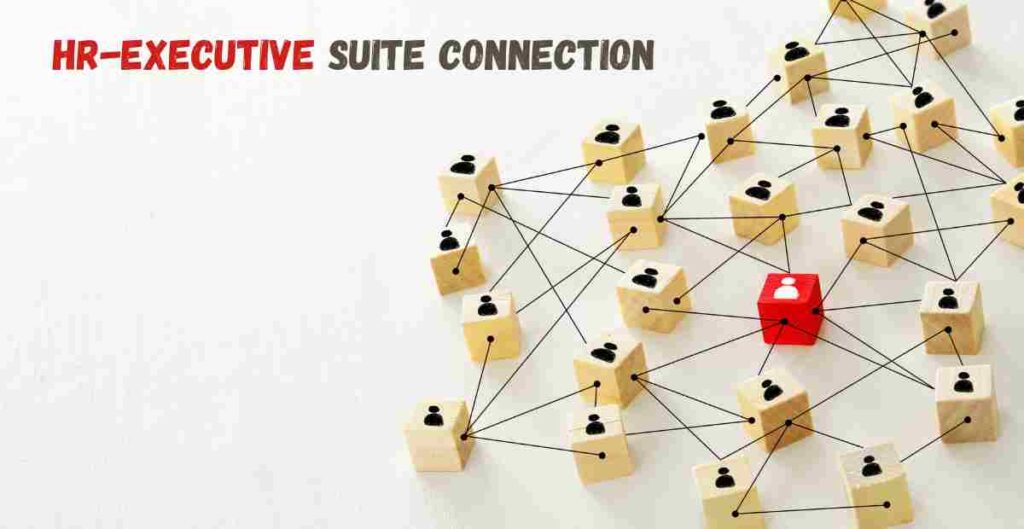In the world of business, connections are crucial. Just as a bridge connects two shores, the HR-Executive Suite Connection acts as the crucial link between human resources and the executive leadership. It is a vital bond that harmonizes strategic business decisions with HR policies. But, what exactly is this connection, and why do businesses need it? Let’s dive in!
Unpacking the HR-Executive Suite Connection

The HR-Executive Suite Connection isn’t just a fancy term; it’s a strategic alliance that enhances the business’s bottom line. This connection is all about HR Executives taking a seat at the executive table, involving themselves in high-level decisions, and acting as a bridge between the organization’s workforce and its leaders.
Indeed, HR Executives are no longer confined to the traditional roles of hiring, firing, and maintaining compliance. They now have a more profound role – one that aligns HR strategies with the overall business objectives, drives organizational growth, and brings an executive summary of the HR department to the executive suite.
The Role of the HR Executive

In today’s dynamic business environment, the importance of this connection cannot be overstated. Here are a few reasons why your business needs to foster the HR-Executive Suite Connection:
- Executive Leadership: An HR executive can provide valuable input into the company’s strategic direction based on their in-depth understanding of the organization’s talent capabilities, fostering a culture of leadership in business.
- Performance Management: With a place at the executive table, HR can align talent management strategies with business goals, ensuring everyone is moving in the right direction.
- Workforce Planning: HR’s insight into the workforce can help inform executive leadership about potential gaps in skills or capabilities, aiding in strategic workforce planning.
- Policy Alignment: HR executives can ensure that company policies and procedures are in line with the strategic vision of the business, fostering a more cohesive and productive working environment.
How to Foster the HR-Executive Suite Connection
Now that we’ve established the importance of this connection, let’s delve into some strategies to foster it:
- Communication: Frequent and open communication between the HR department and executive leadership is key. HR executives should have a seat at the decision-making table, offering their insights and perspectives on strategic business decisions.
- Understanding Business Goals: HR professionals need to understand the organization’s strategic objectives. This knowledge allows HR to align their policies and practices with the company’s goals, fostering a more cohesive business environment.
- Executive Leadership Program: Implementing an executive leadership program can provide HR executives with the skills and knowledge needed to contribute effectively to high-level decisions. Through these programs, HR professionals can gain an understanding of the business landscape, financial management, and strategic planning.
Why is the HR-Executive Suite Connection Important?
When HR executives actively participate in the decision-making process, businesses can reap numerous benefits. These include:
- Improved Decision-Making: With HR’s input, executives can make better-informed decisions about talent management, workforce planning, and policy development.
- Better Employee Engagement: HR’s insights into employee needs and expectations can help executives create strategies that improve employee engagement and satisfaction, leading to increased productivity.
- Strategic Alignment: HR can ensure that talent management strategies align with business goals, promoting strategic alignment and business success.
Enhancing the HR-Executive Suite Connection through an Executive Leadership Program
An executive leadership program can be an effective way to strengthen the HR-Executive Suite Connection. Such a program can equip HR Executives with the skills and knowledge needed to understand and contribute to the organization’s strategic goals.
Additionally, these programs can provide executives with a deeper understanding of the value of HR. They can learn how HR’s insights into the workforce can inform their decisions, and how HR policies and practices can be leveraged to achieve the company’s goals.
Conclusion
The HR-Executive Suite Connection is no longer an option; it’s a necessity for modern businesses. By fostering this connection, businesses can enhance decision-making, improve employee engagement, and promote strategic alignment. It’s time for HR to step up, take a seat at the executive table, and play a crucial role in steering the company towards success.
FAQs (Frequently Asked Questions)
What is the connection between HR and the executive suite?
Top companies manage their human capital as strategically as their financial capital, bringing HR leaders into the strategic decision-making process. HR leaders can apply their insights to discussions with C-suite executives on strategic opportunities and direction, performance improvement, and competitive threats.
What is the role of HR in an organization’s human capital strategy?
HR can become the top resource for a company’s human capital strategy. They can work closely with the C-suite, board of directors, and senior leadership team to ensure the successful execution of the organization’s strategy1.
What is the difference between HR and HR executive?
All aspects related to employee management fall under the responsibility of Human Resources (HR). Whether it is hiring new talent through recruitment or providing various benefits such as training modules and compensation packages- all such facets are encapsulated under HR purview. A significant member within this function is an HR Executive who ensures efficient delivery of these services while adhering to relevant policies & strategies .This role often involves facilitating communication between upper management and employees alongside overseeing operational style due to organizational layout.
Who is above an HR Executive?
The structure within a companys’ human resource department often varies. Nevertheless beyond the role occupied by an executive in this area might be other higher ranking designations like that for a human resource (HR) manager or director; vice president overseeing issues related to personnel; or chief human resources officer (CHRO). These vocations typically demand greater accountability in complex activities like policymaking as well as managing the overall workings of such offices across organizations.
What is the HR executive level?
One of the most crucial aspects in managing a successful organization lies within its ability to hire competent employees – however recruitment alone is not enough. Strategic planning underpins employee management too. In practice,this job is executed by individuals occupying senior most positions within human resources – referred to collectively as the HR executive level. A title reserved for those occupying high-profile roles namely; HR Directors, Vice President’s post holders,and those serving as Chief Human Resource Officers (CHRO). These executives develop initiatives that dovetail workforce management efforts with business objectives. To achieve this collaborative efforts with other executives like the CEO and CFO are vital.
What is the salary of an HR Executive in India?
In India, the compensation HR Executives receive can differ greatly due to their years of experience, company type and magnitude as well as geographical area of employment. Based on reports obtained till September 2021 indicate that commonly they earn an average annual income between 3-4 lakhs INR. Although it is crucial to bear in mind that this amount may vary considerably owing to these listed parameters. To attain reliable and contemporary details,

